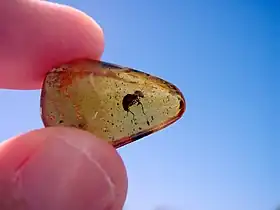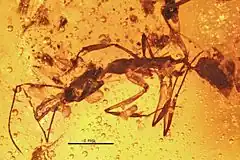Ambre dominicain
L'ambre dominicain est un ambre de la République dominicaine. La résine d'un arbre de la famille des Fabaceae, appartenant à l'espèce disparue Hymenaea protera, en est à l'origine, comme probablement à celle de la plupart des ambres découverts dans les pays tropicaux.
| Ambre dominicain | |
 Fragment d'ambre dominicain contenant un termite. | |
| Localisation | |
|---|---|
| Pays | |
| Informations géologiques | |
| Période | Miocène inférieur à moyen |
| Âge | 20,4 à 13,8 Ma |
| Lithologie principale | Ambre |
L'ambre dominicain se différencie de l'ambre de la Baltique par sa transparence constante et le grand nombre de fossiles qu'il contient. Il est le témoin de l'existence d'une forêt tropicale disparue[1].
Datation
Une étude du début des années 1990 a donné un âge de 40 millions d'années[2]. Cependant, selon George Poinar[1], l'ambre dominicain daterait de l'Oligocène au Miocène et aurait donc environ 25 millions d'années.
Des datations plus récentes de cet ambre (2007) indiquent un âge sensiblement plus récent, entre 20,4 et 13,8 Ma (millions d'années), soit du Miocène inférieur à moyen (étages Burdigalien et Langhien)[3].
Sites miniers
La République dominicaine compte trois principaux sites d'exploitation de l'ambre : la Cordillère septentrionale dans le nord, et Bayaguana et Sabana de la Mar (en) dans l'est. Dans le nord, l'ambre se trouve dans des conglomérats, emportés avec des fragments de grès et d'autres sédiments dans un environnement de delta[4] - [5] - [6].
L'ambre le plus ancien et le plus dur provient de la région montagneuse au nord de Santiago de los Caballeros (mines de La Cumbre, La Toca, Palo Quemado, La Bucara et Los Cacaos (en)[7]). On trouve également de l'ambre dans le sud-est, dans la région de Bayaguana/Sabana de la Mar (en). Il existe enfin dans les dépôts de Cotuí du copal sub-fossile, qui a moins de 280 ans[8].
Dans l'est, l'ambre se trouve dans une formation sédimentaire constituée d'une alternance de sable, d'argile sableuse, de lignite intercalaire, ainsi que de lits solvatés de gravier et de calcarénite[9].
Les deux régions semblent avoir fait partie du même bassin sédimentaire et avoir été séparées plus tard par des mouvements le long de failles importantes[10].
Exploitation
L'ambre dominicain, et particulièrement l'ambre bleu, est exploité en creusant des puits, ce qui est extrêmement dangereux. Le puits en question est un simple trou creusé avec les moyens locaux, machettes, pelles, pioches et marteaux. Il s'enfonce verticalement ou horizontalement aussi loin que possible. Il est rarement assez grand pour s'y tenir debout. Les mineurs s'y glissent à genoux, avec des bougies et des outils à manches courts.
Les mesures de sécurité sont quasiment inexistantes et ces mines doivent être abandonnées au moment des pluies, car elles se remplissent d'eau[11].
Paléobiologie
De nombreux organismes ont été identifiés dans les ambres dominicains :

fourmi fossile de l'ambre dominicain.
Flore
Faune
- Acanthostichus hispaniolicus[13]
- Anelaphus velteni[14]
- Anochetus ambiguus[15]
- Anochetus brevidentatus[16]
- Anochetus conisquamis[15]
- Anochetus corayi [17]
- Anochetus dubius[15]
- Anochetus exstinctus[15]
- Anochetus intermedius[15]
- Anochetus lucidus[15]
- Apterostigma electropilosum[18]
- Apterostigma eowilsoni[18]
- Araneagryllus
- Augochlora leptoloba
- Azteca alpha[19]
- Azteca eumeces[19]
- Cephalotes dieteri
- Cephalotes obscurus
- Dicromantispa electromexicana[20]
- Dicromantispa moronei[20]
- Eickwortapis
- Elaphidion inclusum
- Elaphidion tocanum
- Electromyrmococcus[21]
- Formicodiplogaster myrmenema[22]
- Leptofoenus pittfieldae
- Lutzomyia adiketis[23]
- Neocorynura electra
- Nesagapostemon
- Oligochlora
- Palaeoplethodon hispaniolae
- Paleoleishmania neotropicum[23]
- Plectromerus grimaldii
- Plectromerus tertiarius
- Pterolophosoma otiliae
- Proplebeia abdita Greco et Engel[24], 2011
- Proplebeia dominicana Wille et Chandler[25], 1964
- Proplebeia tantilla J. M. F. Camargo[26], 2000
- Proplebeia vetusta J. M. F. Camargo[26], 2000
- Sphaerodactylus dommeli[27]
- Stizocera evanescens
- Syndesus ambericus [28]
- Tainosia[29]
- Termitaradus mitnicki
- Triatoma dominicana
- Trypanosoma antiquus
Notes et références
- (en) George Poinar, Jr. and Roberta Poinar, 1999. The Amber Forest: A Reconstruction of a Vanished World, (Princeton University Press) (ISBN 0-691-02888-5)
- Malcolm W. Browne, « 40-Million-Year-Old Extinct Bee Yields Oldest Genetic Material », New York Times, (lire en ligne, consulté le )
- (en) Santiago R. Ramírez, Barbara Gravendeel, Rodrigo B. Singer, Charles R. Marshall & Naomi E. Pierce, « Dating the origin of the Orchidaceae from a fossil orchid with its pollinator », Nature, vol. 448, no 7157, , p. 1042–1042 (PMID 17728756, DOI 10.1038/nature06039, lire en ligne)
- (en) Leif Brost and Ake Dahlstrom. The Amber Book, Geoscience Press, Inc., Tucson, AZ, 1996 (ISBN 0-945005-23-7)
- (de) Wilfred Wichard und Wolfgang Weitschat: Im Bernsteinwald. - Gerstenberg Verlag, Hildesheim, 2004, (ISBN 3-8067-2551-9)
- (en) Baroni Urbani, C. & Saunders, J.B. (1980): The fauna of the Dominican Republic amber: the present status of knowledge. – Memorias, 9a geologica del Caribe, 1: 213-223; Santo Domingo. (Published 1983).
- Alec Corday, « Dominican Amber Mines: The Definitive List » [archive du ], The Blue Amber Blog, (consulté le )
- (de) Schlee, D. (1984): Notizen über einige Bernsteine und Kopale aus aller Welt. Stuttgarter Beitr. Naturk. Ser. C, 18: 29-47, page 35
- (de) Schlee, D. (1984): Besonderheiten des Dominikanischen Bernsteins. – Stuttgarter Beitr. Naturk., C, 18: 63-71; Stuttgart.
- (en) Manuel A. Iturralde-Vennet 2001. Geology of the Amber-Bearing Deposits of the Greater Antilles. Caribbean Journal of Science, Vol. 00, No. 0, 141-167, 2001
- (de) Martínez, R. & Schlee, D. (1984): Die Dominikanischen Bernsteinminen der Nordkordillera, speziell auch aus der Sicht der Werkstaetten. – Stuttgarter Beitr. Naturk., C, 18: 79-84; Stuttgart.
- Découverte des premiers pollens d'orchidée fossiles 30 août 2007
- (en) M. L. De Andrade, « First description of fossil Acanthostichus from Dominican amber (Hymenoptera: Formicidae) », Mitteilungen der Schweizerischen Entomologischen Gesellschaft, vol. 71, , p. 269–274
- (en) Bezark, Larry G. A Photographic Catalog of the Cerambycidae of the World.
- (en) M. L. De Andrade, « Fossil Odontomachiti Ants from the Dominican Republic (Amber Collection Stuttgart: Hymenoptera, Formicidae. VII: Odontomachiti) », Stuttgarter Beiträge zur Naturkunde. Serie B (Geologie und Paläontologie), vol. 199, , p. 1–28
- (en) W. P. MacKay, « Anochetus brevidentatus, new species, a second fossil Odontomachiti ant (Hymenoptera: Formicidae) », Journal of the New York Entomological Society, vol. 99, , p. 138-140
- (en) C. Baroni Urbani, « Anochetus corayi n. sp., the first fossil Odontomachiti ant. (Amber Collection Stuttgart: Hymenoptera, Formicidae. II: Odontomachiti) », Stuttgarter Beiträge zur Naturkunde. Serie B (Geologie und Paläontologie), vol. 55, , p. 1–6
- (en) T.R. Schultz, « The fungus-growing ant genus Apterostigma in Dominican amber. », Memoirs of the American Entomological Institute, vol. 80, , p. 425–436
- (en) E.O. Wilson, « Ants of the Dominican amber (Hymenoptera: Formicidae). 3. The subfamily Dolichoderinae. », Psyche, vol. 92, , p. 17–37 (DOI 10.1155/1985/20969)
- (en) MS Engel et DA Grimaldi, « The neuropterid fauna of Dominican and Mexican amber (Neuropterida, Megaloptera, Neuroptera) », American Museum Novitates, vol. 3587, , p. 1–58 (DOI 10.1206/0003-0082(2007)3587[1:TNFODA]2.0.CO;2)
- (en) M.S. Johnson et al., « Acropyga and Azteca Ants (Hymenoptera: Formicidae) with Scale Insects (Sternorrhyncha: Coccoidea): 20 Million Years of Intimate Symbiosis », American Museum Novitates, vol. 3335, , p. 1–18 (DOI 10.1206/0003-0082(2001)335<0001:AAAAHF>2.0.CO;2)
- (en) G.O. Poinar, « The Evolutionary History of Nematodes: As Revealed in Stone, Amber and Mummies », Nematology monographs and perspectives pages, vol. 9, , p. 91–93, 239–240, 324–325
- (en) G. Poinar, « Lutzomyia adiketis sp. n. (Diptera: Phlebotomidae), a vector of Paleoleishmania neotropicum sp. n. (Kinetoplastida: Trypanosomatidae) in Dominican amber », Parasites & Vectors, vol. 1, no 1, , p. 22 (PMID 18627624, PMCID 2491605, DOI 10.1186/1756-3305-1-22)
- (en) M. K. Greco and M. S. Engel. 2011. Proplebeia abdita name, in Description of an ancient social bee trapped in amber using diagnostic radioentomology. Insectes Sociaux 58: p. 491-492
- (en) A. Wille and L. C. Chandler. 1964. A new stingless bee from the Tertiary amber of the Dominican Republic (Hymenoptera; Meliponini). Revista de Biología Tropical 12: p. 187-195
- (en) J. M. F. Camargo. 2000. The Extinct Fauna of Stingless Bees (Hymenoptera: Apidae: Meliponini) in Dominican Amber: Two New Species and Redescription of the Male of Proplebeia dominicana (Wille and Chandler). American Museum Novitates 3293: p. 1-24
- (en) Juan Diego Daza, « http://onlinelibrary.wiley.com/doi/10.1111/jzs.12001/abstract A reconsideration of Sphaerodactylus dommeli Böhme, 1984 (Squamata: Gekkota: Sphaerodactylidae), a Miocene lizard in amber », Journal of Zoological Systematics and Evolutionary Research, Wiley Online Library, jan 1, 2012 (26 sep 2012 online) (ISSN 1439-0469, DOI 10.1111/jzs.12001) :
« Subsequent to the acceptance of this paper, we obtained high resolution X-ray computed tomography imagery for the paratype of Sphaerodactylus dommeli that confirms that it is correctly allocated to genus. Details of its osteology will be reported elsewhere. »
- (en) R.E. Woodruff, « A new fossil species of stag beetle from Dominican Republic amber, with Australasian connections (Coleoptera: Lucanidae) », Insecta Mundi, vol. 0098, , p. 1–10 (lire en ligne)
- (en) J. Szwedo et A. Stroiński, « Tainosia quisqueyae gen. and sp. nov. from the Oligocene/Miocene Dominican amber (Hemiptera: Fulgoroidea: Nogodinidae) », Genus, vol. 12, no 1, , p. 29–34 (lire en ligne)
Sources
- (en) Cet article est partiellement ou en totalité issu de l’article de Wikipédia en anglais intitulé « Dominican amber » (voir la liste des auteurs).
Voir aussi
Article connexe
Liens externes
- (en) Bibliographie sur l'ambre en République dominicaine, Christine Lipkin, Université de Bristol.